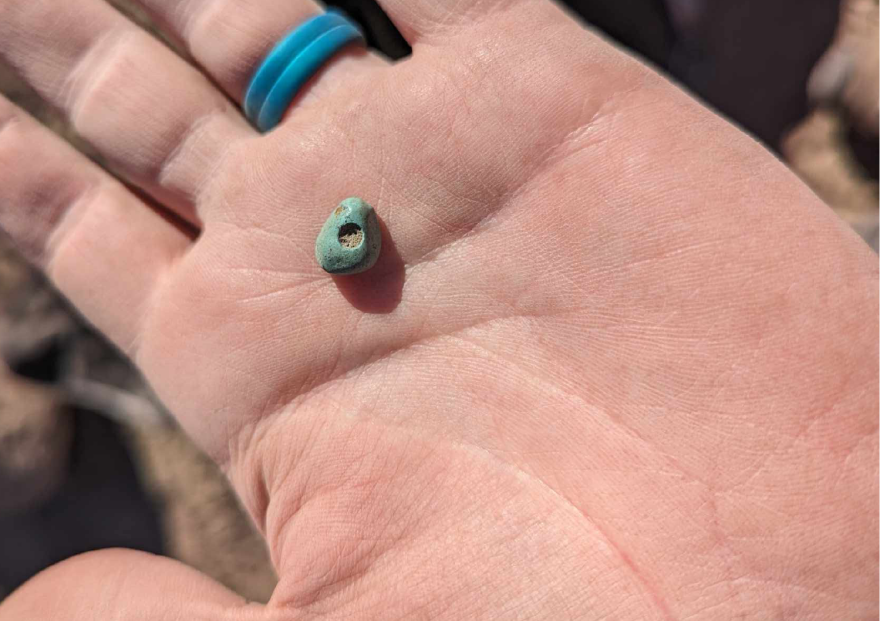Big Bend Ranch State Park is promoted as “the Other Side of Nowhere,” and the park’s River Road – FM 170 between Lajitas and Redford – fits that billing. It’s a breathtaking landscape of volcanic badlands and imposing canyons, and it can seem like a timeless wilderness, untouched by history.
But that’s not the case. Archeologists have been exploring the Rio Grande corridor here in recent years. What they’ve found has exceeded their expectations – and opened a new vantage on the dynamism, and deep continuities, of Indigenous life in the Big Bend.
Tim Gibbs is the park archeologist at Big Bend Ranch archeologist.
“And so mostly as a method for due diligence with our historical commission reviewer,” he said, “we started shovel testing these sites – and pretty well immediately started finding a lot more than we thought was going to be there.”
Gibbs is charged with identifying and safeguarding the park’s archeological resources, and in 2022, he began a survey along the Rio Grande. As he said, it was mostly “due diligence” – finding intact archeology seemed unlikely. After all, the river is at its most violent in these canyon reaches: In its periodic flooding, wouldn’t it have destroyed whatever sites once existed?
At two dozen spots, Gibbs and his crew began “shovel testing,” digging into the earth like archeological prospectors. To their surprise, multiple sites yielded abundant artifacts – arrowheads, ceramics, charcoal. Next, Gibbs sought the input of specialists in geoarchaeology.
Instead of destroying archeological evidence, they learned, the river had preserved it. In spots where eddies form during floods, evidence of human activity was inundated, but then sealed with mud as floodwaters withdrew. The process was repeated – preserving signs of human occupation across time in distinct layers. It’s the vivid “layer-cake stratigraphy” archeologists crave.
“You have very high-integrity depositional environments that are unlike the environments that you see almost anywhere in the region,” Gibbs said, “or really anywhere in the Southwest. These kinds of sites are not supposed to exist.”
Through radiocarbon dating, Gibbs learned these riverside sites dated to between 1300 and 1600 CE. Then, another find deepened the picture.
Framed by striking hoodoos, Crow Town was featured in the 1996 TV miniseries, “The Streets of Laredo.” Then it became a party spot. Volunteers spent years cleaning it up. But in 2024, Gibbs’s team began shovel testing here – and found a density of prehistoric artifacts. They excavated a massive earth oven – a place where plants, like lechuguilla and sotol, had been slow-roasted.
Then they discovered something even more arresting – the remnants of a stone wall. Soon, they’d identified 10 to 15 structures.
“That makes this a village,” Gibbs said. “So we now have a village site in Big Bend Ranch at a location that we had never thought that anything was preserved. All assumptions are now out the window.”
The village likely dates to the 1500s or 1600s.
Teasing out the implications of these discoveries could take years. But there are tantalizing hints.
Artifacts like pottery and turquoise beads indicate that in the 1300s, Big Bend people were connected to farming societies in present-day El Paso and Chihuahua. But those Puebloan-type societies collapsed around 1450. Big Bend people then embraced new technologies – ones associated with bison hunting. Perhaps the Crow Town villagers made seasonal forays to the plains, to hunt bison.
The riverside finds suggest that these Big Bend dwellers were deeply rooted here, but also adaptable to changing circumstances. And they remind us of the limits of archeological understanding, Gibbs said.
“That has been Big Bend archeology for me for 30 years,” he said. “The more I understand, the more I realize that none of us really understand the role this place held.”
This story was made possible by generous donations from supporters like you. Please consider showing your support with a contribution today.



